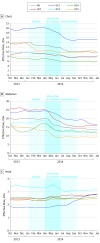Optimizing Radiation Doses for Computed Tomography Across Institutions: Dose Auditing and Best Practices
- PMID: 28395000
- PMCID: PMC5818828
- DOI: 10.1001/jamainternmed.2017.0445
Optimizing Radiation Doses for Computed Tomography Across Institutions: Dose Auditing and Best Practices
Abstract
Importance: Radiation doses for computed tomography (CT) vary substantially across institutions.
Objective: To assess the impact of institutional-level audit and collaborative efforts to share best practices on CT radiation doses across 5 University of California (UC) medical centers.
Design, setting, and participants: In this before/after interventional study, we prospectively collected radiation dose metrics on all diagnostic CT examinations performed between October 1, 2013, and December 31, 2014, at 5 medical centers. Using data from January to March (baseline), we created audit reports detailing the distribution of radiation dose metrics for chest, abdomen, and head CT scans. In April, we shared reports with the medical centers and invited radiology professionals from the centers to a 1.5-day in-person meeting to review reports and share best practices.
Main outcomes and measures: We calculated changes in mean effective dose 12 weeks before and after the audits and meeting, excluding a 12-week implementation period when medical centers could make changes. We compared proportions of examinations exceeding previously published benchmarks at baseline and following the audit and meeting, and calculated changes in proportion of examinations exceeding benchmarks.
Results: Of 158 274 diagnostic CT scans performed in the study period, 29 594 CT scans were performed in the 3 months before and 32 839 CT scans were performed 12 to 24 weeks after the audit and meeting. Reductions in mean effective dose were considerable for chest and abdomen. Mean effective dose for chest CT decreased from 13.2 to 10.7 mSv (18.9% reduction; 95% CI, 18.0%-19.8%). Reductions at individual medical centers ranged from 3.8% to 23.5%. The mean effective dose for abdominal CT decreased from 20.0 to 15.0 mSv (25.0% reduction; 95% CI, 24.3%-25.8%). Reductions at individual medical centers ranged from 10.8% to 34.7%. The number of CT scans that had an effective dose measurement that exceeded benchmarks was reduced considerably by 48% and 54% for chest and abdomen, respectively. After the audit and meeting, head CT doses varied less, although some institutions increased and some decreased mean head CT doses and the proportion above benchmarks.
Conclusions and relevance: Reviewing institutional doses and sharing dose-optimization best practices resulted in lower radiation doses for chest and abdominal CT and more consistent doses for head CT.
Conflict of interest statement
Figures
Comment in
-
Communicating Context in Quality Improvement Reports.JAMA Intern Med. 2017 Jun 1;177(6):817-818. doi: 10.1001/jamainternmed.2017.0461. JAMA Intern Med. 2017. PMID: 28395019 No abstract available.
Similar articles
-
Comparison of the Effectiveness of Single-Component and Multicomponent Interventions for Reducing Radiation Doses in Patients Undergoing Computed Tomography: A Randomized Clinical Trial.JAMA Intern Med. 2020 May 1;180(5):666-675. doi: 10.1001/jamainternmed.2020.0064. JAMA Intern Med. 2020. PMID: 32227142 Free PMC article. Clinical Trial.
-
International variation in radiation dose for computed tomography examinations: prospective cohort study.BMJ. 2019 Jan 2;364:k4931. doi: 10.1136/bmj.k4931. BMJ. 2019. PMID: 30602590 Free PMC article.
-
A Comprehensive CT Dose Reduction Program Using the ACR Dose Index Registry.J Am Coll Radiol. 2015 Dec;12(12 Pt A):1257-65. doi: 10.1016/j.jacr.2015.07.020. Epub 2015 Oct 21. J Am Coll Radiol. 2015. PMID: 26475376
-
Adult patient radiation doses from non-cardiac CT examinations: a review of published results.Br J Radiol. 2011 Apr;84(1000):293-303. doi: 10.1259/bjr/69070614. Epub 2011 Jan 25. Br J Radiol. 2011. PMID: 21266399 Free PMC article. Review.
-
Medical exposure to radiation and thyroid cancer.Clin Oncol (R Coll Radiol). 2011 May;23(4):244-50. doi: 10.1016/j.clon.2011.01.159. Epub 2011 Feb 5. Clin Oncol (R Coll Radiol). 2011. PMID: 21296564 Review.
Cited by
-
Use of radiation dose index monitoring software in a multicenter environment for CT dose optimization.Radiol Med. 2018 Dec;123(12):944-951. doi: 10.1007/s11547-018-0925-0. Epub 2018 Aug 9. Radiol Med. 2018. PMID: 30094542 Review. No abstract available.
-
Cumulative Doses of Ionizing Radiation From Computed Tomography: A Population-Based Study.Mayo Clin Proc. 2019 Oct;94(10):2011-2021. doi: 10.1016/j.mayocp.2019.05.022. Epub 2019 Jun 24. Mayo Clin Proc. 2019. PMID: 31248696 Free PMC article.
-
Cone beam computed tomography-guided thin/ultrathin bronchoscopy for diagnosis of peripheral lung nodules: a prospective pilot study.J Thorac Dis. 2018 Dec;10(12):6950-6959. doi: 10.21037/jtd.2018.11.21. J Thorac Dis. 2018. PMID: 30746241 Free PMC article.
-
Computed Tomography of the Head : A Systematic Review on Acquisition and Reconstruction Techniques to Reduce Radiation Dose.Clin Neuroradiol. 2023 Sep;33(3):591-610. doi: 10.1007/s00062-023-01271-5. Epub 2023 Mar 2. Clin Neuroradiol. 2023. PMID: 36862232 Free PMC article.
-
Comparison of the Effectiveness of Single-Component and Multicomponent Interventions for Reducing Radiation Doses in Patients Undergoing Computed Tomography: A Randomized Clinical Trial.JAMA Intern Med. 2020 May 1;180(5):666-675. doi: 10.1001/jamainternmed.2020.0064. JAMA Intern Med. 2020. PMID: 32227142 Free PMC article. Clinical Trial.
References
-
- Medicare Part B Imaging Services Rapid spending growth and shift to physician offices indicated need for cms to consider additional management practices [GAO-08-452]. Washington DC; 2008. http://www.gao.gov/new.items/d08452.pdf. Accessed August 8, 2016.
Publication types
MeSH terms
Grants and funding
LinkOut - more resources
Full Text Sources
Other Literature Sources
Medical
Miscellaneous


